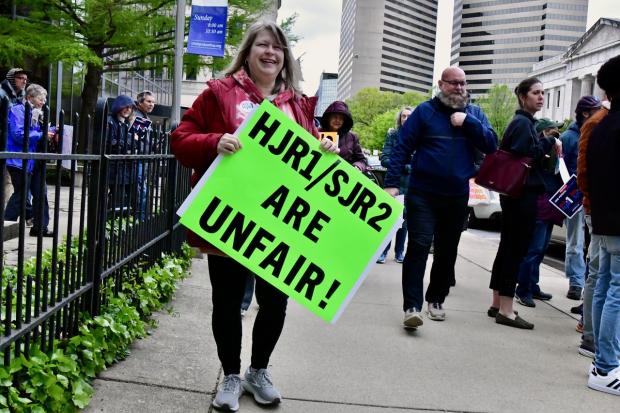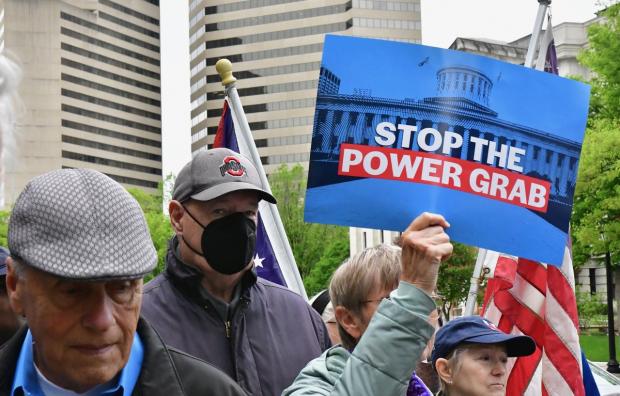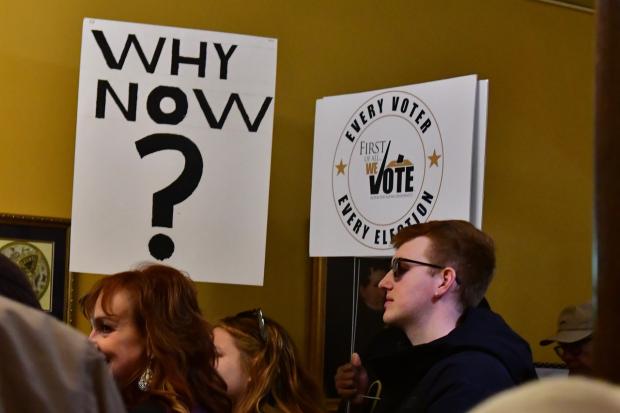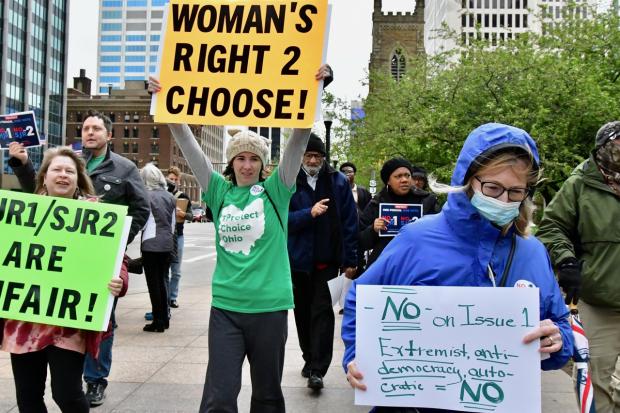Advertisement
Recent weeks have seen several stories of states seeking to silence legislators going against the powers that be. The expulsion of two lawmakers from the Tennessee legislature advocating for gun control efforts was followed by a session-long ban placed on Montana Rep. Zooey Zephyr for protesting the state’s proposed ban on gender-affirming care. In this race to the bottom to silence dissent and subvert the democratic process, however, Ohio’s recent effort stands out. The Ohio legislature's recent effort seeks not just to silence individual minority legislators, but to potentially ignore the will of a majority of Ohioans.
House Joint Resolution 1 (HJR 1) seeks to change Ohio’s system for referendums to amend the state’s constitution, making the entire process more difficult. First, it would eliminate the so-called “cure” period, where groups attempting to get a referendum on the ballot can gather additional signatures while also requiring signatures from all 88 Ohio counties instead of the currently mandated 44. Most vitally, the bill would raise the threshold needed to approve an amendment to 60 percent from the current 50 percent. Thus, presenting a potential situation where the will of 59 percent of Ohioans could be subordinate to a 41 percent minority.
Ohio’s system of initiative amendments has been in place since 1912, so the question arises: why? Why this particular moment to change a system of voter-initiated referendums that has served Ohio voters for over 100 years? The answer is revealed by the timing. It is widely expected that a voter initiative asking Ohioans to enshrine a limited right to abortion in the state will be on the ballot in November. While the passage of such an amendment is by no means a guarantee, the recent success of a pro-choice amendment in Michigan, and the failure of pro-life amendments in Republican states such as Kentucky and Kansas has left Ohio Republicans and pro-life activists concerned about the potential outcome of a pro-choice amendment in Ohio.
The idea of allowing abortion rights to be legislated by the states was a common refrain of the pro-life movement. At the heart of Justice Samuel Alito’s opinion in Dobbs v. Jackson Women’s Health Organization was a seeming desire to let the states decide to what extent abortion would be allowed within their borders. Yet with HJR 1, Ohio Republicans seem intent on preemptively denying a majority of Ohioans a say on how abortion rights should be viewed in the state.
HJR 1’s primary sponsor Brian Stewart (R-Ashville) and other Ohio Republicans have sought to paint the bill as protecting the state’s constitution against malicious out-of-state interests. Putting aside the obvious hypocrisy of the Ohio GOP, a party that contained former Speaker of the House Larry Householder now convicted of racketeering, sounding the alarm on out-of-state interests, Stewart’s rationale simply does not hold up to scrutiny. For one, there is no evidence that out-of-state interests have been abusing the state initiative system for nefarious purposes. Ohio has not been experiencing a rash of ballot amendments, seeing only five being initiated by the voters since 2010. Next, the only out-of-state interests that seem to be involved in this situation are GOP super-PACS and billionaire donors running ads in the state.
This concern about “out-of-state” interests coming in to buy the Ohio Constitution seems to betray a fundamental distrust of Ohio’s voters to express themselves directly. Rep. Stewart himself gives this away. Referring to nearly 70 percent of Ohioans who approved amendments in 2015 and 2018 to reform redistricting in the state, Stewart discounted this overwhelming majority by claiming that “maybe 10 percent of those voters actually read or understand the amendments.” This view seems to paint Ohio’s electorate as confused and non-thinking, willing to approve whatever is put in front of them.
The hypocrisy of HJR 1 is only made worse when paired with Senate Bill 92 (SB. 92). Since HJR 1 would merely create a ballot issue on the question of the proposed changes, it would have to go before the voters to be approved. SB 92 would allow the creation of an August special election to consider statewide ballot initiatives. This seems to further disprove the Ohio GOP’s flimsy excuses for changing the initiated amendment process. The rush to put HJR 1 before the voters in August instead of November seems squarely focused on a potential November abortion initiative. Beyond this, the hypocrisy of this move should rankle even the most jaded of political observers. It was the Ohio GOP, after all, who spearheaded the push for House Bill 458 (HB 458), which eliminated the August special election in almost all circumstances and was signed by Governor DeWine in January of this year.
When HB 458 was introduced, its sponsor, State Representative Thomas Hall (R-Madison Twp.) minced no words in describing why the state should eliminate August special elections, declaring that they were “costly to taxpayers and fail to engage a meaningful amount of the electorate in the process.” Rep. Hall’s evaluation of August special elections is correct on both counts. Fiscally, SB 92 allocates twenty million dollars of taxpayer money to hold such an election, a significant sum. Electorally, in the 2022 August special election, a mere 631,000 Ohioans cast ballots, a paltry 8 percent of the electorate. Presumably the media coverage of HJR 1 and the implications for an abortion ballot initiative would raise political participation in a potential 2023 August special election. However, it is still likely that a crucial decision about how the will of Ohioans is reflected in the state constitution would be decided by a miniscule minority of Ohio voters.
HJR 1 has drawn criticism from all sides of the political aisle. Four former governors, two from each party, have come out against HJR 1, including most recently former governor Bob Taft. Taft’s letter to the Ohio General Assembly expressing his opposition was quick to point to quotes from current Ohio GOP members denouncing August special elections, including Secretary of State Frank LaRose, who described August special elections as unhealthy for “the taxpayer, elections officials, voters or the civic health of our state.”
To review, HJR 1 would enshrine a form of minority rule, cutting off one of the last direct ways Ohio voters can influence the state free of interference, and to achieve this, Ohio Republicans want to reinstall an election that mere months ago they derided as wasteful and undemocratic. Even as the hypocrisy and realpolitik of the Ohio Republican party reaches untold proportions, there remains hope. HJR 1 still needs to progress through the legislature and while Governor DeWine has expressed plans to sign SB 92, it is by no means a foregone conclusion. Political pressure may still yet cause Ohio Republicans to reconsider this misguided attempt at limiting the voice of the people. Failing that, it will be up to Ohioans to rally to the ballot box and defend their right to directly influence their Constitution.









